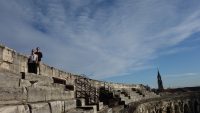 Rome had the Gaul to leave tons of Roman-related sights around southern France, and a couple of the best ones are in the city of Nimes. After breakfast, we took the thirty-minute train to Nimes to see what we would see.
Rome had the Gaul to leave tons of Roman-related sights around southern France, and a couple of the best ones are in the city of Nimes. After breakfast, we took the thirty-minute train to Nimes to see what we would see.
Beauty, actually. As soon as we left the train station, we walked onto a wide, tree-lined pedestrian way that ran over half a mile to a square with a fountain, and although the fountain was off for the winter, the long artificial stream running the entire length of the pedestrian way was still full of water. Since train stations are not always in the most scenic part of the town, the welcome-to-Nimes was pretty special.
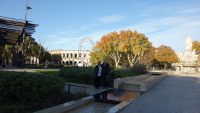 As soon as we got to the dry fountain, which in itself was fun to look at, with sculptures all around, we could see the amphitheater we had come to see (Dubbs says NEVER to call an amphitheater a coliseum since that is the one in Rome). The coliseum in Nimes is the best preserved one in the world, since it was used as a fortress for much of the post-Roman history of the town. It is one of the twenty biggest, seating 24,000 spectators when it was built. Once again, we mostly had the place to ourselves. Other than a few workers, the entire place only had three or four other tourists in it, and they mostly were on the other side of the arena.
As soon as we got to the dry fountain, which in itself was fun to look at, with sculptures all around, we could see the amphitheater we had come to see (Dubbs says NEVER to call an amphitheater a coliseum since that is the one in Rome). The coliseum in Nimes is the best preserved one in the world, since it was used as a fortress for much of the post-Roman history of the town. It is one of the twenty biggest, seating 24,000 spectators when it was built. Once again, we mostly had the place to ourselves. Other than a few workers, the entire place only had three or four other tourists in it, and they mostly were on the other side of the arena.
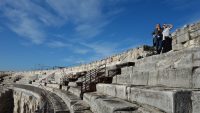 We had audioguides, which presented a description of typical gladiatorial games – highly anticipated combats that crowds loved, but that rarely ended in the death of the gladiator – gladiators were too expensive to train, and if one died, the sponsor had to pay a large sum of money to the school from which the gladiator came. The audioguides also had us climbing all over the place, to the point where we found ourselves climbing a ridiculously small staircase that came out on the top wall and top seats. We chose the seats and not the no-railing wall. The view was spectacular, with the coliseum in the foreground, the for-Christmas Ferris wheel behind, and a church steeple behind. All in all, we spent almost an hour and a half tromping around the place.
We had audioguides, which presented a description of typical gladiatorial games – highly anticipated combats that crowds loved, but that rarely ended in the death of the gladiator – gladiators were too expensive to train, and if one died, the sponsor had to pay a large sum of money to the school from which the gladiator came. The audioguides also had us climbing all over the place, to the point where we found ourselves climbing a ridiculously small staircase that came out on the top wall and top seats. We chose the seats and not the no-railing wall. The view was spectacular, with the coliseum in the foreground, the for-Christmas Ferris wheel behind, and a church steeple behind. All in all, we spent almost an hour and a half tromping around the place.
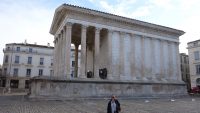 On to the next Roman ruin! Or not-so-ruined. We went on to the Maison Carree (“square house”) a few blocks away. The Maison Carree is the best preserved Roman temple in the world, again, because it has been in continuous use – as a church, a house, a storage barn, and more. The temple was dedicated to Caesar Augustus’ grandsons, and is, as far as I can tell, completely intact. There used to be other buildings all around the temple, but they are gone. The temple now shows a short film on the founding and Roman history of Nimes. The short version – the Celtic people who lived here chose to support Julius Caesar in his wars against the northern Gauls. They picked the winning side, and were granted status as a Roman colony, with Roman citizenship available to important members of the city.
On to the next Roman ruin! Or not-so-ruined. We went on to the Maison Carree (“square house”) a few blocks away. The Maison Carree is the best preserved Roman temple in the world, again, because it has been in continuous use – as a church, a house, a storage barn, and more. The temple was dedicated to Caesar Augustus’ grandsons, and is, as far as I can tell, completely intact. There used to be other buildings all around the temple, but they are gone. The temple now shows a short film on the founding and Roman history of Nimes. The short version – the Celtic people who lived here chose to support Julius Caesar in his wars against the northern Gauls. They picked the winning side, and were granted status as a Roman colony, with Roman citizenship available to important members of the city.
 It was a beautiful day today, so we sprang to eat on the terrace of the cafe at the museum that overlooks the Maison Carree. The food was fussy to my taste, but I ate Dubbs’ potatoes and had dessert, all while getting to look at the temple in the pretty square. The meal was pricey, but we were paying for the experience, and it was worth it.
It was a beautiful day today, so we sprang to eat on the terrace of the cafe at the museum that overlooks the Maison Carree. The food was fussy to my taste, but I ate Dubbs’ potatoes and had dessert, all while getting to look at the temple in the pretty square. The meal was pricey, but we were paying for the experience, and it was worth it.
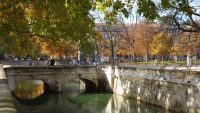 We next headed toward Jardin de la Fontaine (the Fountain Garden). We got a good approach, walking along the canal that exits the garden, and so we got to see the garden unfold as we came up to it. The town was named from the name of the deity of the spring here, which should give you an indication of the amount of water we are taking about. This is not a fill-up-your-bottle kind of spring – it is a full lagoon, multiple pools, and running canal kind of gushing supply of water. All of this is at the base of a good-sized hill, so the gardens run up the slope. It is one of the prettiest urban parks I have ever seen. And it also has a Roman ruin at the bottom and at the top of the hill.
We next headed toward Jardin de la Fontaine (the Fountain Garden). We got a good approach, walking along the canal that exits the garden, and so we got to see the garden unfold as we came up to it. The town was named from the name of the deity of the spring here, which should give you an indication of the amount of water we are taking about. This is not a fill-up-your-bottle kind of spring – it is a full lagoon, multiple pools, and running canal kind of gushing supply of water. All of this is at the base of a good-sized hill, so the gardens run up the slope. It is one of the prettiest urban parks I have ever seen. And it also has a Roman ruin at the bottom and at the top of the hill.
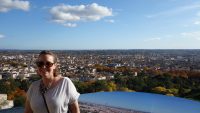 The “Temple of Diana” is a ruined hall of some kind that scientists agree was not dedicated to Dianna and was almost certainly not a temple. It is from the first century, and is still striking, and so was fun to explore. Then came the trek up the hill, which was not a small walk. At the top was the Magne Tower, a Roman tower that was once the highest point along the seven-kilometer wall around the city. The tower has lost the top story since it was built, but is still climbable inside, and gives a grand view of the city.
The “Temple of Diana” is a ruined hall of some kind that scientists agree was not dedicated to Dianna and was almost certainly not a temple. It is from the first century, and is still striking, and so was fun to explore. Then came the trek up the hill, which was not a small walk. At the top was the Magne Tower, a Roman tower that was once the highest point along the seven-kilometer wall around the city. The tower has lost the top story since it was built, but is still climbable inside, and gives a grand view of the city.
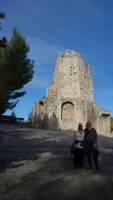 Back down the hill, through the amazing park, and back into the center (with a pause in a park to watch old men play boules, the French version of bocce, followed by a detour for pastry near the Maison Carree), all the way back to the coliseum, and to the Musee de la Romanite (the Museum of the Romans). The Musee tells the story of Nimes from the pre-Roman time up through the Middle Ages, with a long focus on the Romans, in chronological order.
Back down the hill, through the amazing park, and back into the center (with a pause in a park to watch old men play boules, the French version of bocce, followed by a detour for pastry near the Maison Carree), all the way back to the coliseum, and to the Musee de la Romanite (the Museum of the Romans). The Musee tells the story of Nimes from the pre-Roman time up through the Middle Ages, with a long focus on the Romans, in chronological order.
It is an excellent little museum, combining two-thousand-year-old artifacts with modern technology. So they had mosaics, which were impressive, but then they would project close-up images of parts of the mosaic, or they would project in the missing parts of a fresco on a wall. On inscriptions, they would use projectors to deepen the contrast on the marble, to make it easier to read, and provided a translation (in French) under the Latin. They had a wonderful topographical map onto which they projected Nimes, showing the town at different times through the centuries (it shrank down for much of the post-Roman period). Finally, there was a display where you were virtually dressed in Roman garb, but it was done automatically. I may have appeared as a first-century woman on a screen. Fun museum.
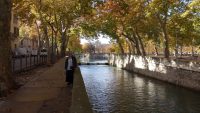 That ended the evening in Nimes, and we caught the train back to Avignon, where we got take-away food from a food stall. We figured we had eaten “classy” at lunch. Too many meals like that and we could be ruined.
That ended the evening in Nimes, and we caught the train back to Avignon, where we got take-away food from a food stall. We figured we had eaten “classy” at lunch. Too many meals like that and we could be ruined.